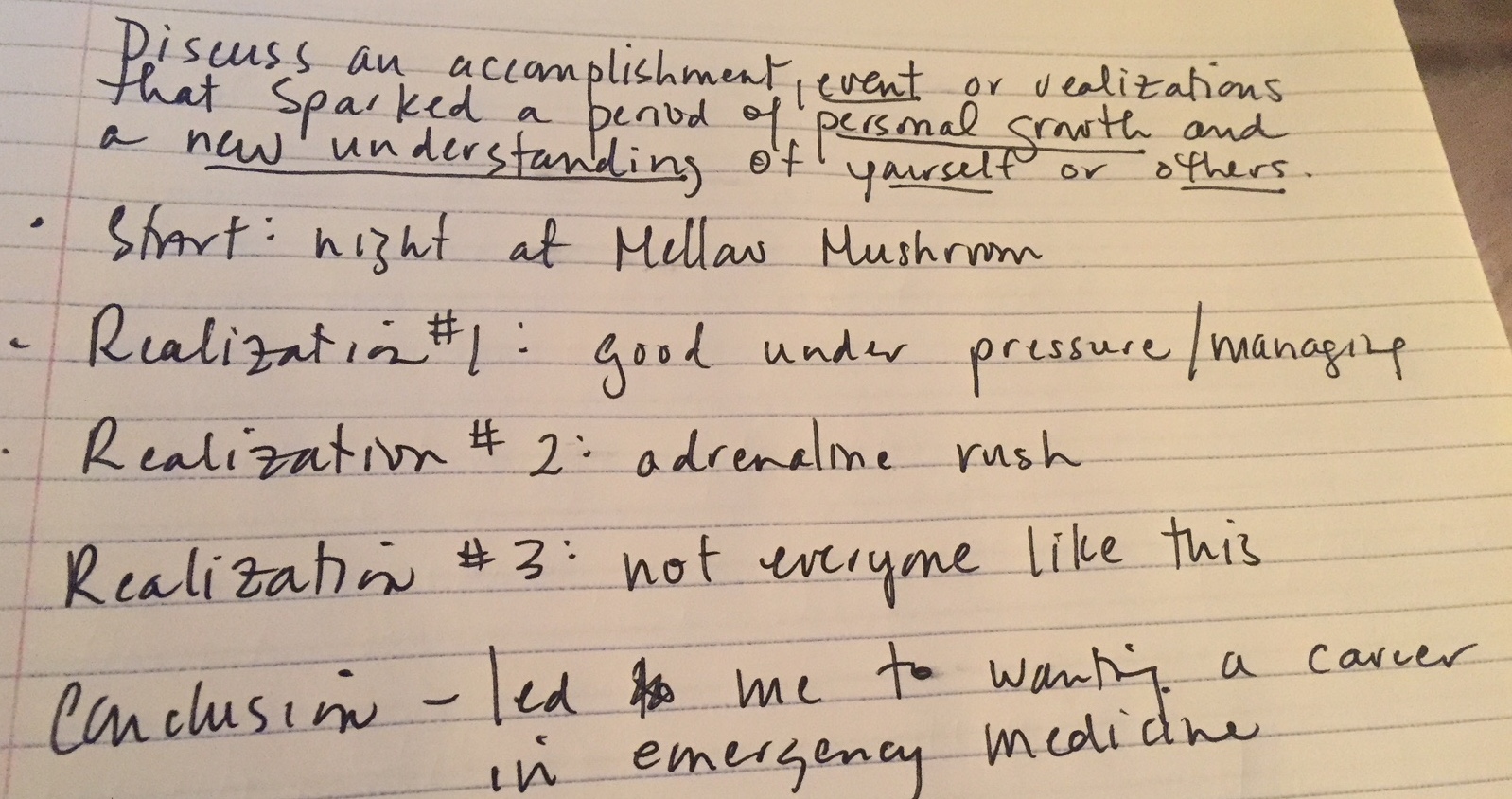It’s one thing to know what you want to write about (if you don’t, click here and here). it’s another to bang out a first draft. Sometimes getting those first words down on paper comes easily, sometimes the process feels impossible. Sometimes you get to the end of a first draft and realize you skidded off on a tangent that did nothing to answer your prompt. Sometimes you get midway through and either don’t know where to go next or hate your direction.
In any of these events, it’s helpful if you can establish a plan from the outset, not only to arm yourself against Doubt (and yes, that word is scary enough that it warrants capitalization), but also to save yourself time in the long run.
So, let’s start by making an outline.
DEVELOP YOUR OUTLINE
An outline can feel like a task, but it doesn’t have to be complicated. It can simply be a few bullet points that break down where you want to start, what points you want to make along the way, and where you want to end up. And the time invested is worth it. For the 10 (yes, 10) minutes you invest in writing an outline, you can save hours in the long run.
Say you are tackling this prompt from the Common Application: “Discuss an accomplishment, event, or realization that sparked a period of personal growth and a new understanding of yourself or others.”
In your mind, you have already isolated the event that made you change. Let’s say you were working as a hostess at the pizza place Mellow Mushroom when a woman started choking on a pretzel bite. While she was choking, a lot of people realized there was a problem, but no one seemed to know what to do except stand around her. You stepped in, stood on a chair, cupped your hands around your mouth bullhorn-style and very loudly addressed the restaurant: “Does anyone know the Heimlich maneuver?” A nurse, who’d been in another room munching on a slice of Kosmic Karma, ran over and saved the day. But you saved the day, too, by thinking cooly under pressure.
Here is what your outline could look like (and as complicated as it needs to be):

Notice the outline starts with the exact wording of the prompt. I underlined what words/points need to be addressed. Then I broke down the realizations that were made that night and how those realizations effected change.
In this case, the incident made this theoretical “you” realize you want a career in emergency medicine. But the conclusion doesn’t have to be career related. It can teach you about the power of people working together. It can teach you about what gratitude looks like. Whatever your event or incident, really dig deep and think about what it meant to you. Be as clear and honest as you can be about it, and you will produce a good essay. In fact, that should be a formula: Honesty + clarity = A+

EXPECT UGLY
Now that you’re armed with your outline, it’s time to write your first draft. Now is also the time for you to absorb the following:
- This is the hardest part of the process and it is for everyone.
- Hammer it out anyways, even if it’s terrible.
- You are making progress even if you don’t think so.
- Re-writing doesn’t mean restarting.
In her book Everybody Writes, Ann Handley calls this part of the process TUFD, which stands for The Ugly First Draft. I love this idea because I think deep down we all hope that if we plan enough and are smart enough, brilliance will start flowing from our fingers the minute we begin. When mush comes out instead, we want to give up.
But if you know it’s going to be bad before you even start and that, with time, it is going to get better, then you save yourself a lot of heartache.
RECREATE YOUR MOMENT
Start by vividly reconstructing your moment or story. Let’s say we’re back in the pizza place. Access every sense (what did it feel like? Look like? Smell like? Sound like?) and remember every last detail in the room. What were people wearing? Doing? Saying? What music was playing? Most importantly, what did you do? Think? Feel? Want? Overcome?
No detail is too small here, OK? In fact, the tiniest, most mundane details can lead to magic in your essay; that’s what gives it authenticity and honesty. So paint this portrait as accurately as you can.
As you bang this bloody thing out, constantly refer back to the wording of the prompt and your outline to keep you on track.
In this case, we’re recreating a moment in which you realized something important.
After you’ve recreated your moment, write about what it made you realize about yourself. Do those traits/values surface in other parts of your life? Write (briefly) about them. For example, say you realized you’re good under pressure. What was another circumstance in your life where this trait surface? When you were at, say, a DECA competition? Or volunteering at a hospital? Write about that.
In general, as shown in the outline, it’s useful if you can highlight three or four different elements of your character/life in your essay, whether that means showcasing traits or whether that means writing about important parts of your biography. The goal of the opening story is to give you an opportunity to showcase your character, but to also act as a springboard to write about other parts of your life.
If you’re doing this right, your first draft is likely going to run long. Granted, it will initially feel like you’re never going to reach 650 words. But as you go, you’ll realize it’s closer than you think. In fact, if you are trying and trying to stretch it out to 650 words for hours at a time, then you probably don’t have the right topic because you don’t have enough to say. The purpose of this essay is for admissions officers to learn about you: to get an idea of how you will contribute to their program and fit in on campus, about how your mind works, about what you’re made of. That’s a whole lot to fit into only 650 measly words. So, if you’re on the right track, you will have more to say than what you have room for.
AGAIN, REMEMBER: FIRST DRAFTS ARE UGLY
Ultimately, the purpose of the first draft is to simply get out what you have to get out. If you occasionally use bullet points, if you type yourself notes like “NEED BETTER WORD HERE” or “GO BACK LATER AND REWRITE,” and, especially, if your writing is coming out as casually as you speak? Keep going, because all of this is a good thing.

And when you’re done? And you’re left with this grammatically-pulverized, long-winded, braggy and incomplete draft? It’s time to treat yourself to a hot fudge sundae, my friend, because the very hardest part of your school application is done. Insert trophy emoji here.


